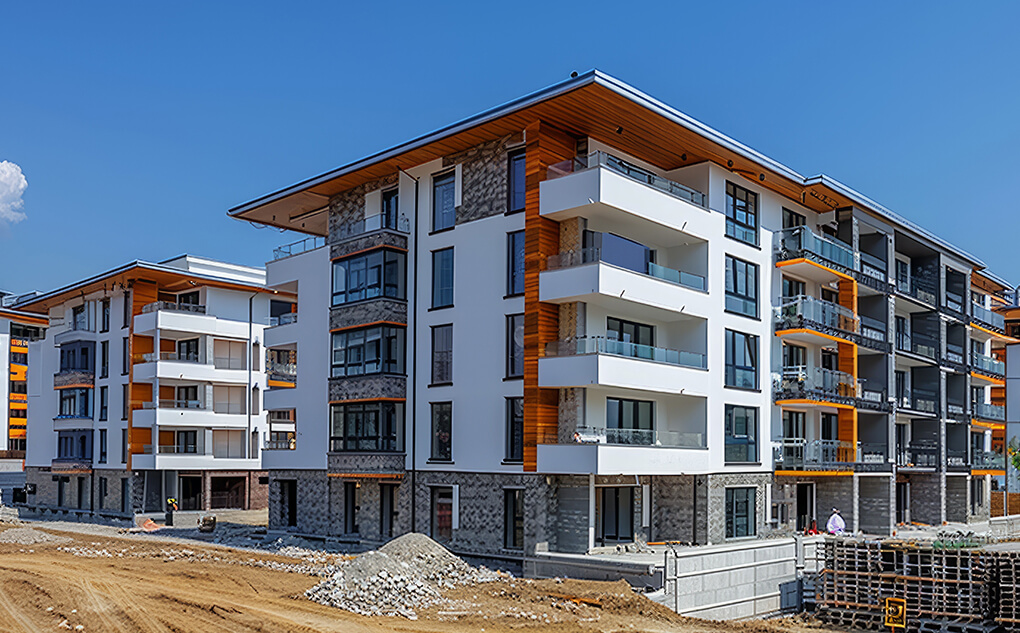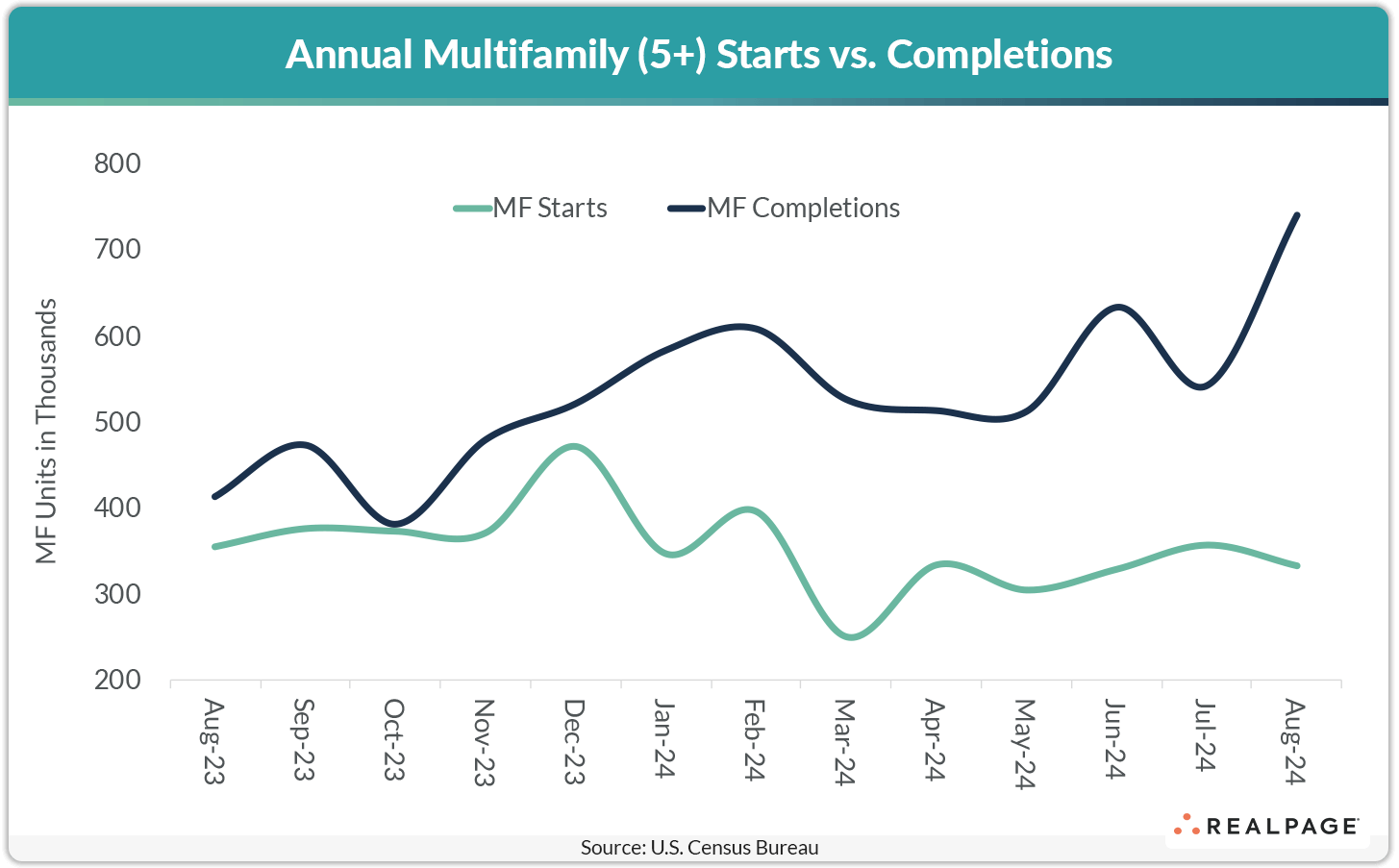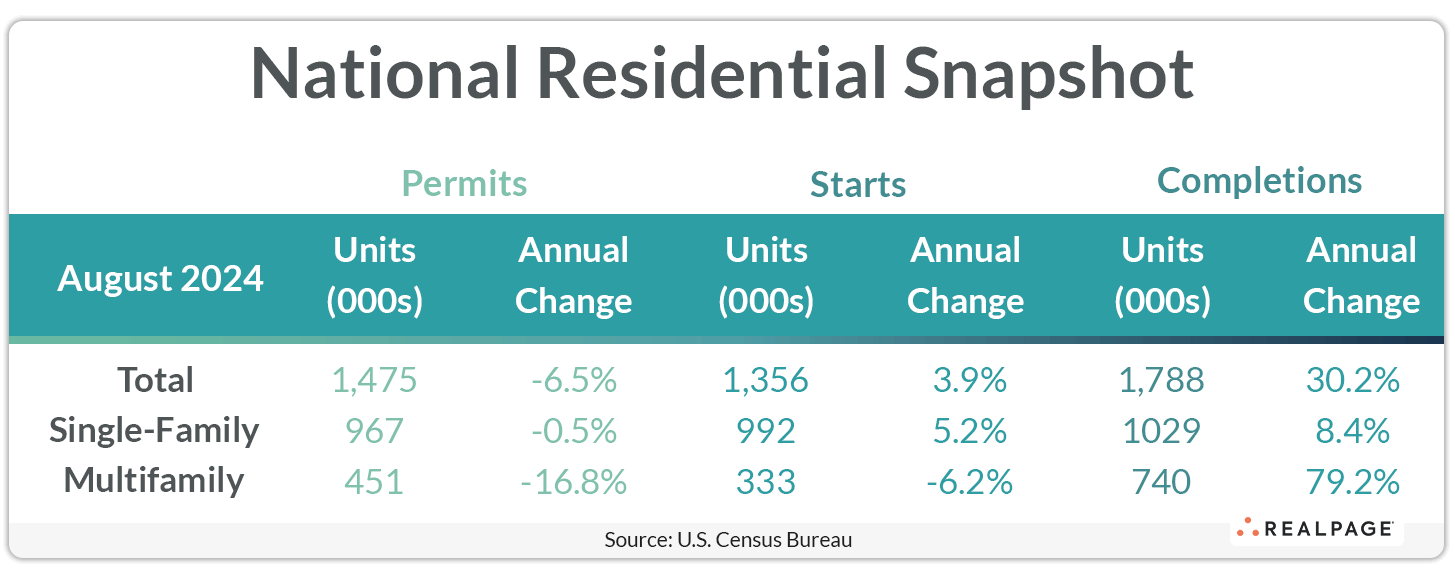More apartments have been completed in the last year than at any point in the last 50.
Annualized multifamily completions totaled 740,000 units for the first time since April 1974. That was a 36.5% increase from July’s seasonally adjusted total of 542,000 units and 79.2% above last August's total, according to the latest report from the U.S. Census Bureau and the Department of Housing and Urban Development.
Multifamily starts fell more than 6% for the month and year to 333,000 units, while units under construction also were down from July and last August at 850,000 units. Annualized multifamily permitting jumped 8.4% from July to 451,000 units, but that was down almost 17% from last year. Delays due to permitting backlogs, financing issues and labor and material costs have kept multifamily construction elevated, but the peaks for permits and starts are definitely in the rearview.
Meanwhile, single-family starts were up 15.8% from last month and 5.2% for the year to 992,000 units, reversing the recent downward trend. Single-family starts are expected to increase further throughout the remainder of 2024 as interest and mortgage rates decline. The annualized rate for single-family permitting also increased slightly for the month (2.8%) but was virtually unchanged from last August at 967,000 units.
Single-family completions were down 5.6% for the month but up 8.4% for the year to 1.029 million units. The number of single-family units under construction declined a slight 0.3% from July to 642,000 units and were down 5.2% from one year ago. Single-family units authorized, but not started totaled 148,000 units, up 2.8% for the month and 5.7% for the year.
Together with the small two-to-four unit figures, total residential permitting increased 4.9% from last month but were down 6.5% for the year to 1.475 million units. With August’s increase in annual single-family starts, the SAAR of total residential starts was up 9.6% from last month to 1.356 million units and they were up 3.9% from last year.
Compared to one year ago, the annual rate for multifamily permitting decreased in all four Census regions. The largest decline in annualized multifamily permitting occurred in the West region (down 42% to 85,000 units), while the Northeast region declined -22.4% to 67,000 units and the Midwest region was down 9.5% to 69,000 units. The active South region was down just 1.4% from one year ago with 231,000 units permitted. Compared to the previous month, permitting was down in the Northeast and West regions and up in the South and Midwest.
Annualized multifamily starts decreased sharply in the small Northeast region (down 64.1% to 25,000 units), and significantly in the West (down 28.3% to 63,000 units). The South saw annual starts jump 31% to 190,000 units, while the Midwest was up 5.9% to 54,000 units. Compared to July’s SAAR, starts were down only in the Northeast, more than doubled in the Midwest and up moderately in the West and South regions.
Metro-Level Multifamily Permitting
Nine the top 10 markets from July’s list returned in August with the first three remaining in order.
New York remained the top multifamily market in the 12-months-ending in August with 30,129 units permitted, up about 23% from last year but down slightly from July. Austin returned at #2 with 17,555 units permitted, down about 9% from last year and last month or about 1,750 units.
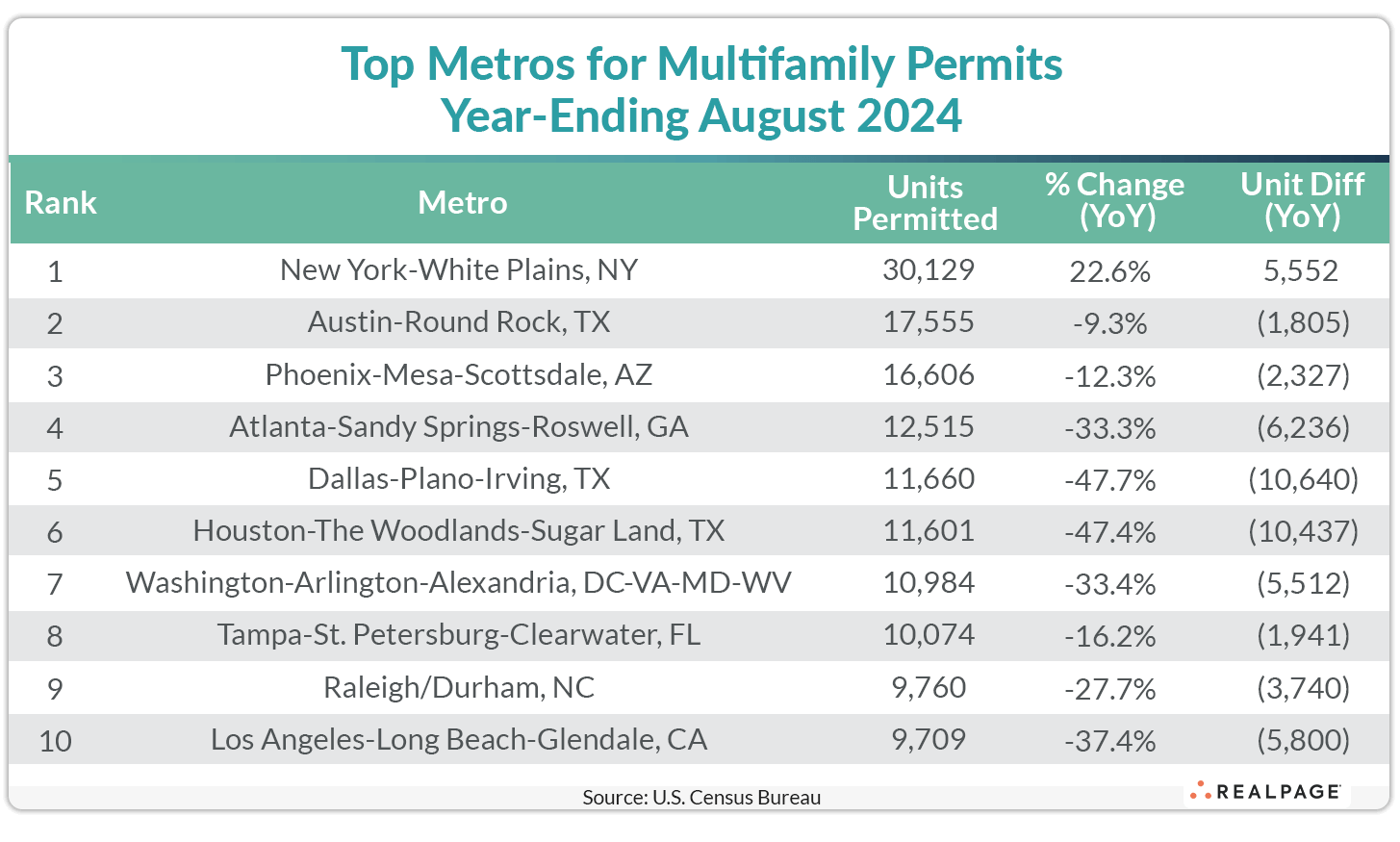
Phoenix remained in the #3 spot, permitting a total of 16,606 units for the year, about even with July but about 12% less than last August. Atlanta saw a 9.7% increase in annual permitting over July’s total to 12,515 units to rank #4, dropping the rapidly decreasing Dallas market to #5 with an August total of 11,660 units, almost half of last year’s total.
Multifamily permitting also continues to slow in Houston with 11,601 units permitted to remain in the #6 spot, 10,437 units less than last year but about 300 units more than July’s total. Washington, DC also remained in place at #7 with 10,984 units permitted through August, but that was down 5,512 units from last year’s pace.
Tampa moved up two spots from last month to #8 with 10,074 units permitted for the year, down 16.2% from last August but close to July’s total. The Raleigh/Durham market jumped onto the top 10 list this month at #9 with 9,760 units permitted for the year (displacing Miami), up 14.4% or 1,227 units from last month and less than half its year-ago pace but close to July’s total. Los Angeles slipped to the #10 spot in August with 9,709 units permitted, 1,038 units less than July’s annual figure and 5,800 units less than last August.
Of the top 10 multifamily permitting markets, all but New York decreased its annual totals from the year before and some were significant declines. Dallas had the largest decrease in annual multifamily permitting of the top 10 markets (-10,640 units), followed closely by Houston (-10,437 units), Atlanta (-6,236 units), Los Angeles (-5,800 units), Washington, DC (-5,512 units), Raleigh/Durham (-3,740 units), Phoenix (-2,327 units), Tampa (-1,941 units) and Austin (-1,805 units).
Other major non-top 10 markets with significant declines in annual permitting include Minneapolis/St. Paul (-7,194 units), San Antonio (-6,242 units), Jacksonville (-5,177 units), Portland, OR (-4,533 units), Nashville (-3,858 units), Denver (-3,841 units), Miami (-3,250 units), Orlando (-3,175 units), Salt Lake City (-3,158 units) and Riverside (-3,154 units).
Other markets with significant year-over-year increases in annual multifamily permitting in the year-ending August were Fort Worth (+3,546 units), Greensboro/Winston-Salem (+1,699 units), Ashville, NC (+1,403 units), Omaha (+1,276 units), Knoxville (+1,267 units), Milwaukee (+1,121 units) and San Diego (+1,098 units).
The annual total of multifamily permits issued in the top 10 metros – 140,593 units – was about 23% less than the 183,479 issued in the previous 12 months and down -1.1% from last month. The total number of permits issued in the top 10 metros was almost equal to the number of permits issued for the #11 through #35 ranked metros.
Below the metro level, eight of last month’s top 10 permit-issuing places returned to this month’s list with only two remaining in the same place. The list of top individual permitting places (cities, towns, boroughs and unincorporated counties) generally include the principal city of some of the most active metro areas.
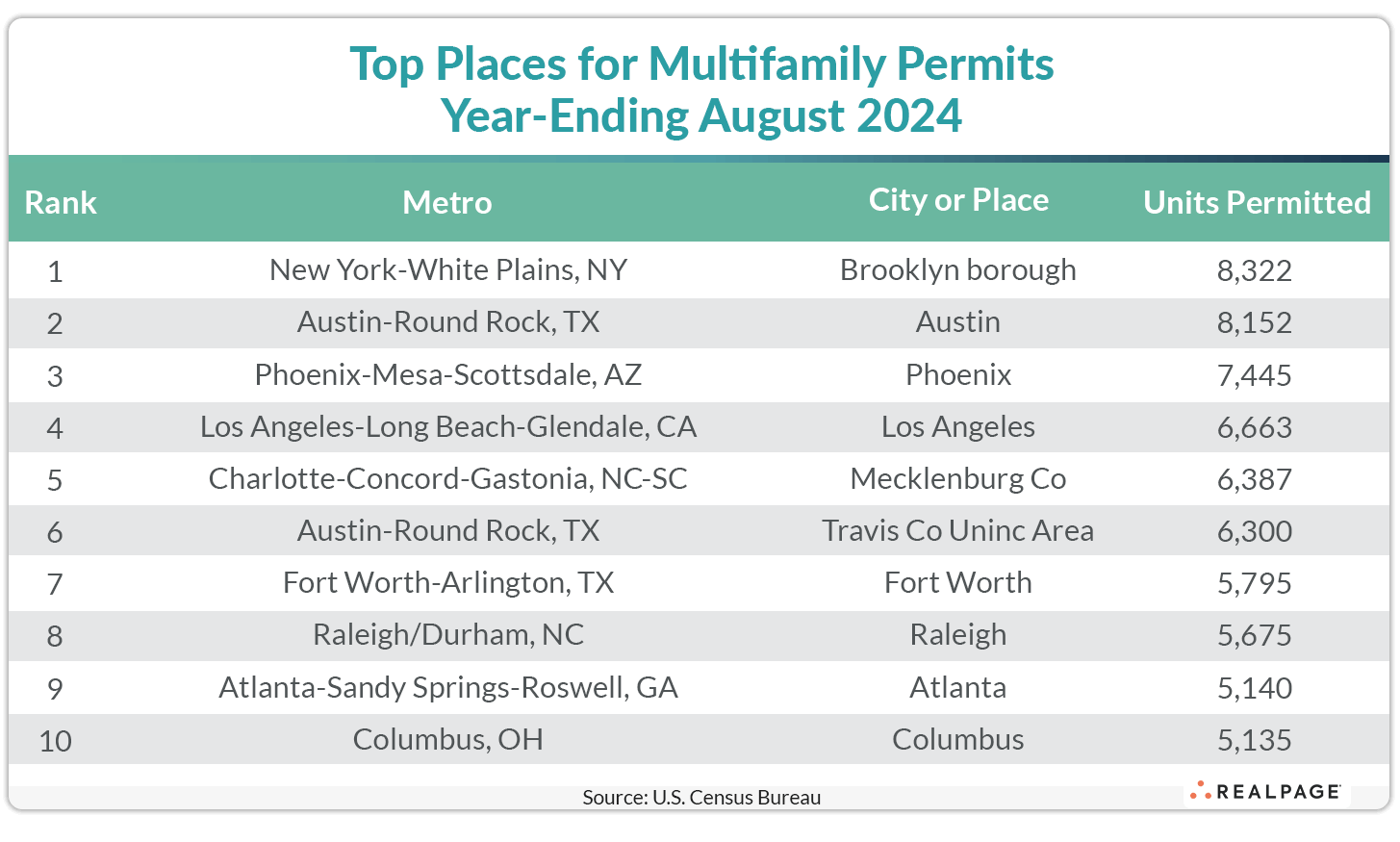
The borough of Brooklyn moved into the #1 spot in August, permitting 8,322 units for the year and moving the city of Austin to the #2 position with 8,152 units permitted, 1,323 units less than in July. The cities of Phoenix and Los Angeles also switched spots at #3 and #4, with 7,445 units permitted in the Valley of the Sun and 6,663 units permitted in the City of Angels.
Mecklenburg County (Charlotte) and Unincorporated Travis County (Austin) were the next pair of permitting places to switch spots this month at #5 and #6 but both permitted about 6,300 units apiece, and each increased by 2% to 4% from July. The city of Fort Worth returned at #7 with 5,795 units permitted, almost even with July’s total, while the city of Raleigh joined the top 10 list at #8 with 5,675 units permitted, up 1,322 units from the month before.
The city of Atlanta moved up from #11 last month to #9 in August, permitting 5,140 units, almost tying returning #10 city of Columbus’ 5,135 units permitted.
While Texas still led all states with six of the top 20 individual permitting places on August’s list, New York state added one place to take four spots and Florida, California and North Carolina each had two permitting places on the top 20 list. The cities of Dallas and Houston barely hung on to the top 20 places list, while other southern cities like Raleigh, Atlanta and Mecklenburg County (Charlotte) moved up.






